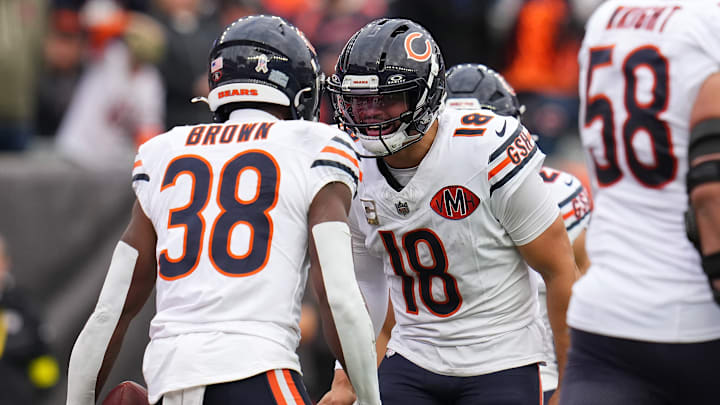Dexter Lawrence, Brian Burns, Kayvon Thibodeaux, rookie Abdul Carter -- the front seven for the Giants looks imposing on paper, but between the lines, the Giants have been anything but consistent against the run.
For the Chicago Bears, it's exactly where there gameplan should start, and end in Week 10.
The numbers tell the story.
Bears' backfield can flip this Giants game on its head
Through nine weeks, New York ranks 31st in the NFL in rushing yards allowed per game (150.0) -- ahead of only the Cincinnati Bengals. Over their last three contests, that number has ballooned to 192.3 yards per game, a staggering total for a defense that’s supposed to thrive on disruption up front. Even worse, when the Giants travel, they’ve been the league’s worst run defense, surrendering 172.2 rushing yards per game away from MetLife Stadium.
Bottom line, it's been ugly for head coach Brian Daboll. But on the opposite side of the coin, it's a heck of an opportunity for the Bears to churn clock, wear down bodies, and put six up on the scoreboard each trip into Giants territory.
It’s simple, really: should the Bears want to win the football game, the ground game has to be the focal point. Whether it’s D'Andre Swift or rookie Kyle Monangai, who broke out last week against Cincinnati with 176 yards on the ground, Chicago’s identity needs to start with running between the tackles, setting a physical tone early, and forcing the Giants’ defense to play from its heels.
Both Swift and Monangai were limited at their first practice, but regardless of who gets the bulk of the carries, the philosophy shouldn’t change. The Bears’ offensive line has quietly been one of the most improved units in football this season -- physical at the point of attack, cohesive in their zone concepts, and versatile enough to get out on the edge. Against a Giants front built to rush the passer, the best counterpunch is to go right at them.
Run the ball. Force them to anchor. Make them tackle in space.
Running the rock also helps Caleb Williams -- not just in the box score, but in rhythm and confidence. A strong run game slows down a pass rush, sets up play-action, and manipulates defensive structure. It forces safeties to creep down, corners to play tighter to the line of scrimmage, and creates those vertical one-on-one looks outside that Williams has thrived on in spurts.
The Bears have the talent on the perimeter to win those matchups -- but it all stems from balance.
November football in Chicago means cold air, swirling winds, and a grass surface that only gets slower as the weeks go on. That’s when running the football matters most.
Read more: Bears' 2025 Midseason Awards: Joe Thuney leads and Kyle Monangai shines bright
The flashy plays from Williams will always draw headlines, but the path to a win in Week 10 runs right through the trenches. Against a Giants defense that has yet to prove it can stop the run, the Bears’ ground game has the chance to control the game -- and flip the week on its head.
